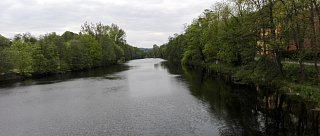Podskalí - Strakonice
The surroundings of the rocky gorge of the Otava River, with meadows on both banks, have long been a recreational area for the town. Inspired by the area was local native and national revival poet F. L. Čelakovský, but it continues to attract other citizens and visitors of Strakonice seeking romantic walks along the riverbanks.
How to get there
You can use some of the parking lots in Strakonice or public transportation.
Additional information
Along both banks of the Otava River in Strakonice, the educational trail Podskalí was established in 1992 and later restored in 2005. Stretching 3 km in length, it highlights aspects such as rafting, local flora, and fauna.
On the right bank of the Otava River in Strakonice's Podskalí, you'll find a replica of a moai statue. In 1982, this replica played a role in solving the mystery of how such statues were transported on Easter Island, thanks to Ing. Pavel Pavel.
A bust of F. L. Čelakovský, a national revivalist, writer, folk literature collector, scientist, and native of Strakonice, stands on Zellerinova Stráň above the Otava River. This location is significant as it relates to his early literary endeavors. The bust was created by sculptor Vojtěch Šíp and was unveiled on June 15, 1924, commemorating the 125th anniversary of F. L. Čelakovský's birth (March 7, 1799 - August 5, 1852). Beneath the current monument, there used to be a ferry crossing to the opposite bank. Today, this viewpoint is one of the stops on the educational trail that leads through Strakonice's Podskalí, across Kalvárie Hill, to Strakonice Castle.
The statue of Dorotka Trnkova, Švanda's bride, also resides in Strakonice's Podskalí. Dorotka symbolizes faithful and true love. Unveiled during the Dudák Year in the summer of 2012, the sitting girl with a wreath, carved from Hořice sandstone, was crafted by academic sculptor Karel Kryška. Below Dorotka, there is a bench where kissing is said to bring happy and contented love.
In a small cave on the backside of Podskalí, a water sprite peeks out behind bars, carved from lime wood and colored appropriately for a hastrman. The sculpture was created by Volyně carver Jaroslav Frencl.

